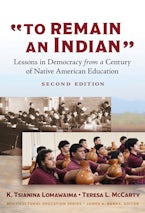Contents
Series Foreword James A. Banks xi
Acknowledgments xvii
Preface to the Second Edition xxiii
Indigenous Sovereignty: Lessons for Democracy and Much More xxiv
Indigenous Nations and the United States xxv
Lessons for Democracy xxvii
Goals for the Second Edition xxviii
What Does “To Remain an Indian” Mean? xxx
Where Do We Stand? xxxi
Overview of the Book xxxiv
1. Illuminating Safety Zones and Sovereignty Zones in a History of Native American Education 1
Schools as “Civilizing” and Homogenizing Institutions 5
Safety Zone Theory: Explaining Policy and Its Development Over Time 8
Methodological and Theoretical Approaches 13
2. The Strengths of Indigenous Education: Overturning Myths About Native Learners 19
Indigenous Education Versus U.S. Schooling 19
How and Why Do Stereotypes Endure? 20
Native Voices Teach Lessons of Shared Humanity 24
Indigenous Knowledge Guides Human Societies 25
Carefully Designed Educational Systems 29
Language-Rich Contexts for Education 32
Learning by Doing 38
A Return to Choice and Local Control 41
3. Women’s Arts and Children’s Songs: Domesticating Indigeneity, 1900–1928 44
Indians as Children: “Insensible Wards” 46
Boarding Schools Versus Day Schools 49
A Political Economy of School Practices: The “Dignity of Labor” 50
Race and the Safety Zone: Designating the Right Place 53
Attempts to Domesticate Indigeneity 60
An Unprecedented Possibility: “To Remain an Indian” 65
Conclusion 68
4. Power Struggles Over How “To Remain an Indian,” 1924–1940 69
Indian Citizenship Act of June 2, 1924 71
Piper v. Big Pine: An Early Ruling on School Desegregation 73
The “New” Vocational Education 75
Native Teachers in the Federal Schools 82
The Revival of Arts and Crafts Instruction 86
The Keystone of Control: Reforms Versus Business as Usual 90
Conclusion 95
5. Control of Culture: Federally Produced Curricular and Bilingual Materials, 1930–1954 96
“Indian History and Lore” Courses 96
The Bureau’s Indian Life Readers Series 100
The Pueblo Life Readers 105
The Sioux Life Readers 107
The Navajo Life Readers 111
The Hopi Life Readers 112
Native Translators and Interpreters 115
New Developments: Publication of Authentically Diné Stories 120
6. Carving Out Zones of Sovereignty: Bilingual-Bicultural Education and “Who Should Control the Schools” 123
Contours of the Safety Zone, 1950–1960 124
The Seeds of Transformation 126
Rough Rock—A School “The People Made for Themselves” 129
Rock Point Community School—Making the Most of a “Window of Opportunity” 135
The Peach Springs Hualapai Bilingual-Bicultural Program—“A School of Choice” 139
The Hard Labor of Sovereignty Zone Construction 143
7. “For the Benefit of My People”: Mobilizing Sovereignty Zones in Indigenous Language Reclamation 146
Mohawk Language Resurgence: “Our People Have Latched Onto the Idea of Becoming Speakers of Their Own Language” 149
Hawaiian Language Resurgence: “We Knew It Was Urgent and We Had People Willing to Take the Risk” 155
Diné Language Resurgence: “Giving Students Access to the Goodness of Being and Speaking Navajo” 163
Myaamia Language Resurgence: “We Must be Conscious Gardeners If We are Going to Have a Community Harvest” 168
A Genealogy of Sovereignty Zone Builders 173
8. Landscapes of Sovereignty Zone Opportunity 178
Landscapes of Opportunity in K–12 Schools 180
Landscapes of Opportunity in Postsecondary Education 189
Lessons in Democracy 197
Notes 201
References 207
Index 233
About the Authors 250

